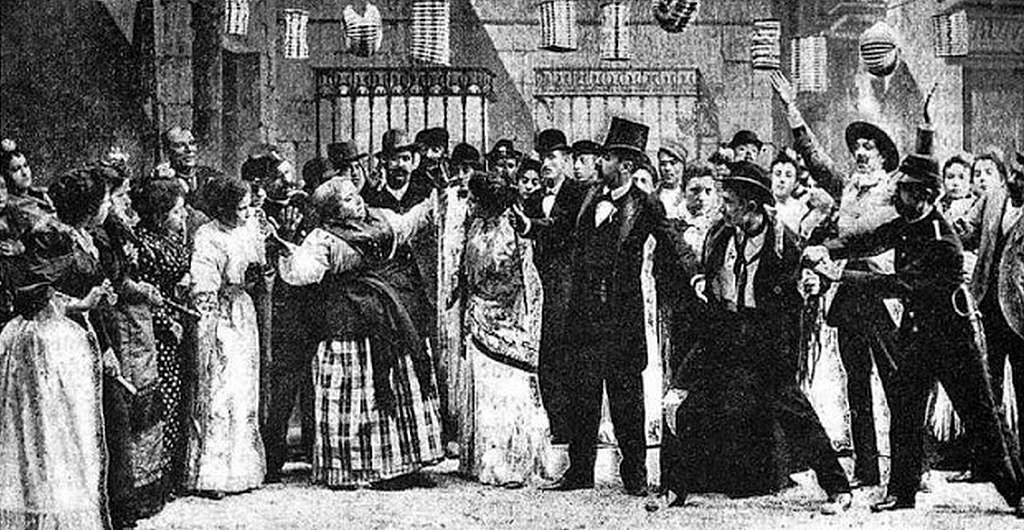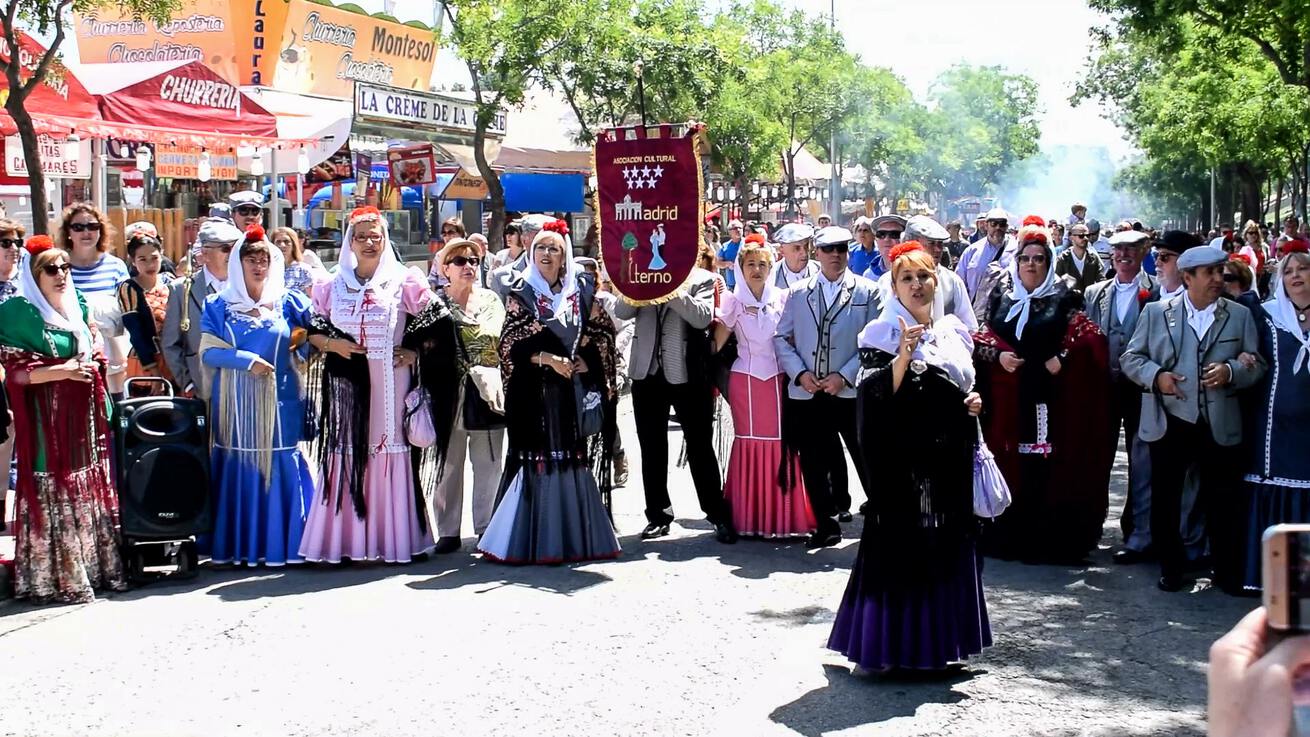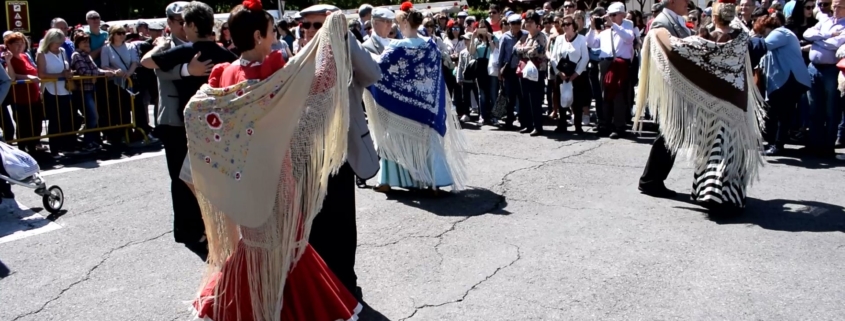El Chotis – The Madrid relative of the Rheinlander and the Bavarian polka
Who would have thought that the typical Madrid folk dance called Chotis to the music of a barrel organ didn’t come from Madrid at all, not even from Spain. Rather, it shows that Germans and Austrians have more in common with Madridians than we are aware of. How this relates to the Chotis, I explain to you in this article.
The polka in the top 10 of the european charts of the 19th century.
The Chotis, which folk dance groups often perform at Madrid festivals such as San Isidro or La Paloma, came to Madrid in the mid-19th century under the name “Polca Alemana”, or “German Polka”. The name Polka comes from Czech and means Polish. The dance itself was originally called půlka (“half”) because of its step change, the half step. But in 1835, in Prague, the capital of the country then known under Bohemia, the name was changed to polka. One assumes, out of sympathy for the poles, which were severely oppressed at the time. (Wikipedia)
From there, the polka quickly spread through Vienna and Paris throughout Europe and became a Central European ballroom dance. I suspect that for the people of this time it was a welcome variation of previously known folk dances. In the Czech Republic, the polka had its pioneer in the Nimra. In German folk dance, it was the Hopser, which dates back to the 18th century. In 1742, for example, Johann Sebastian Bach used a Hopser in his Peasant Cantata. This dance evolved into Hipper in 1811 in the Rhine Franconian region. The Schottisch round dance also uses this step. The name “Schottisch” is probably derived from the Ecossaise (Scottish waltz). It was known as early as 1810.
The spread of the partnered dance Schottisch in large parts of the world
The partnered dance, known as Scottish, spread in many countries around the world, especially in Europe, but also in many countries in Latin America. This happened through the ballrooms frequented by the upper classes. More rustic styles became popular at festivals, and through the immigration of Germans to South America, entered the dance traditions of many countries. The polka-like partnered dance variants of the Schottisch are now viewed under their own name as a folk dance. In Germany and Austria, as well as Switzerland and Sweden, they are known as Rheinländer or Bavarian polka.
In folk dance, polka or Schottisch are not only handed down in European countries such as Austria (Krebspolka), Germany, Switzerland, the Netherlands, Denmark (Tyrolerhopsa), Sweden, Norway, France, Portugal, Italy and of course the Czech Republic, Slovakia and Poland. They are also part of the cultural heritage in Latin American countries such as Argentina, Paraguay, Uruguay, Mexico and Brazil. The Mexican variant in particular reminds me of southern German folk dances if you omit the women’s fans and the men’s hats. Curiously, the dance itself in England is called “schottische” with the German version of the word.
The advent of the chotis, the Madrid variant of Schottisch
The Madrid Chotis is known to have been danced for the first time on November 3, 1850 at the court of Isabel II under the name of “Polca Alemana”. Obviously the participants were so enthusiastic about his rhythm and movements that they carried them on and made them known to the Madrid people. Obviously the participants were so enthusiastic about his rhythm and movements that they carried them on and made them known to the Madrid people. It became popular and the traditional dance par excellence of the Madrid people. The chotis is danced in pairs to the sound of a barrel organ.

It is reported that the typical barrel organ (or organ grinder) was introduced to Madrid by the Italian Luis Apruzzese, who settled in Madrid on the advice of the musician Tomás Bretón. Here he set up a workshop for the manufacture and repair of barrel organs in 1890 in Costanilla de San Andrés Street, and later in Carrera de San Francisco. On the first cylinders of the barrel organs, which reproduce the melody, were engraved simple Austrian rhythms called Schottisch. This then became “Chotis” in Spanish. Then melodies were added that we now identify with traditional Madrid at popular festivals such as the Verbena de la Paloma and San Isidro.
The Chulapos adopt the fashion dance Chotis as their own
If we want to understand how the dance in other countries rather fast in two-quarter time with 3-4 reprises to 8, 12 or 16 bars, often with “hopsern” (see e.g. the varieties Polka hongroise, the Mazurka (Polka masurka), Polka a la Polacca, or even the fast polka by Johann Strauss), could develop into a rather stiff dance, where the woman turns the man, we have to oberve the social realities of Madrid at the end of the 19th and early 20th centuries.
As I wrote in my article about Madrid’s nicknames, a kind of social movement had developed at the beginning of the 19th century whose supporters clearly wanted to stand out from the French social elite they despised with an enlightened attitude.
Especially in the lower classes of Madrid, people expressed their pride and self-confidence through different clothing and characteristic behavior. Depending on the district, people developed their own fashion that we recognize today in the traditional costumes of the Chulapos y Chulapas. This social phenomenon continued until the end of the 19th century and the beginning of the 20th century, reinforced by the sharp increase in the population. They were looking for an identity for the city. On top of that, life in Madrid was rough and associated with a lot of violence and poverty. In order to assert oneself here, one conjors a little arrogance. Behind this is the philosophy: “press on regardless”.
The archetypal character of the “Chulos” (can be translated both as a show-off and a pimp) was always nicely dressed up. He ignored everything in his district and at the folk festival, and therefore didn’t have to move around while dancing.

The spread of the chotis without the zarzuelas is unthinkable
The zarzuela is a typical Spanish genre of musical theater. It is similar to the French opéra comique or operetta. Again, people alternate between speaking and singing. The music of the Zarzuela consists mainly of original compositions, which are supplemented by folk songs or popular hits that match the plot.
The name Zarzuela comes from the Palacio de la Zarzuela palace in Madrid (a palace built in the 17th century by order of King Felipe IV as a hunting lodge). It was the first place where a zarzuela was performed for the first time, namely the eclogue “La Selva sin Amor” (The jungle without love) by Lope de Vega. Calderón de la Barca was the first dramaturge to adopt the term Zarzuela.
The zarzuelas were the key to popularizing the chotis. It was urban music and very popular at the time, because the Zarzuelas took up many topics from everyday life. A chotis could not be missing. Many Zarzuelas tell us about the history and character of the capital. For example:
- La verbena de la Paloma
- Agua, azucarillos y aguardiente
- La Revoltosa
- El barberillo de Lavapiés
- La Gran Via
The chotis is a reflection of life in Madrid until the first half of the 20th century
The texts of the Chotis spoke of the things that happened to the people in Madrid at that time. Some speak of love, others tell little stories and of very traditional districts such as Lavapiés or Chamberí. The chotis of the 19th and early 20th centuries were a very lively reflection of the habits, customs, personalities and gossip of the time.
Some texts refer to a modus vivendi, which from today’s point of view seems to us to be bordering on pimping and gender-based violence. I am referring here in particular to the chotis “El Pichi“, a song from the Spanish music cabaret “Las Leandras” (1931), which is excellently interpreted by Sara Montiel. However, these circumstances were not the subject of social disgrace in the first third of the 20th century. There was even room for sympathetic parody, as with this Chotis. It is therefore a symbol of machism that was still socially acceptable during the republic. The song was so successful that at the time even a doll El Pichi was made for children.
After the civil war, the Chotis, like all folklore in Spain, lost this connection with Madrid life and its freshness, as the dictatorship put him in the straitjacket of patriotism and imposed specific clichés.
How to dance the chotis
According to the literature, the dance movements of the Schottisch in Europe should generally look like this:
“Beat 1: 1 alternating step with the left foot, starting to the left (for men, women opposite) Beat 2: 1 alternating step starting with the right foot to the right (for men) Beat 3–4: turn clockwise in a pair version with 4 steps (the gentleman starting on the left) ”.
See, e. g. ,Wikipedia.
The rural dance movements are supposed to be more derthan than the urban ones.
In contrast, the chotis is a really simple dance that anyone can dance. The most peculiar and curious feature is that it is danced on the surface of an (imaginary) tile or newspaper, i.e. in a very small space.
The gentleman has to stand in this imaginary square space and lean on his tiptoe. The lady moves around him, holding the partner so tight that he turns. She walks three steps forward and three steps backwards in the rhythm of the organ music, crossed or in the form of an eight. Then the turn begins again.
The gentleman turns only through the woman and remains rigid, looking only ahead. He must not leave the imaginary small space.
Madrid
The coolest dancers dare to raise a foot, only turn around a point and leave a hand in the vest pocket. The aim is to display an arrogant attitude that is so characteristic of traditional pride. That’s what The Madriders call “castizo.”
Traditional clothes are worn at the Chotis
As I mentioned before, the clothing of the Chulapos or Chotis dancers is part of their identity. The ladies wear a long dress that is pulled in a little under the knees, a headscarf, a manila scarf and a red carnation on their foreheads.
The men wear black trousers, a white shirt, a gray waistcoat and a “Parpusa”. It’s a kind of cap that has a small visor on the front. It consists of a fabric with small black and white squares. They wear the classic red carnation in their lapels or jacket pockets.
Do you feel like trying it now? Then come to Madrid on May 15th for the San Isidro festival! :-)
This post is also available in: German



Leave a Reply
Want to join the discussion?Feel free to contribute!